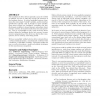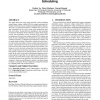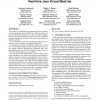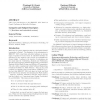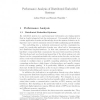107
Voted
EMSOFT
2007
Springer
15 years 4 months ago
2007
Springer
The soundness of device drivers generally cannot be verified in isolation, but has to take into account the reactions of the hardware devices. In critical embedded systems, interf...
120
Voted
EMSOFT
2007
Springer
15 years 4 months ago
2007
Springer
This paper deals with energy-aware real-time system scheduling using dynamic voltage scaling (DVS) for energy-constrained embedded systems that execute variable and unpredictable ...
93
Voted
EMSOFT
2007
Springer
15 years 4 months ago
2007
Springer
Synchronous reactive formalisms associate concurrent behaviors to precise schedules on global clock(s). This allows a non-ambiguous notion of "absent" signal, which can ...
86
Voted
EMSOFT
2007
Springer
15 years 6 months ago
2007
Springer
E-FRP is declarative language for programming resourcebounded, event-driven systems. The original high-level semantics of E-FRP requires that each event handler execute atomically...
120
Voted
EMSOFT
2007
Springer
15 years 6 months ago
2007
Springer
The emergence of standards for programming real-time systems in Java has encouraged many developers to consider its use for systems previously only built using C, Ada, or assembly...
113
Voted
EMSOFT
2007
Springer
15 years 6 months ago
2007
Springer
Architecture description languages are used to describe both the hardware and software architecture of an application, at system-level. The basic software components are intended ...
76
Voted
EMSOFT
2007
Springer
15 years 6 months ago
2007
Springer
81
Voted
EMSOFT
2007
Springer
15 years 6 months ago
2007
Springer
100
Voted
EMSOFT
2007
Springer
15 years 6 months ago
2007
Springer
This paper proposes a scheduling strategy and an automatic scheduling flow that enable the simultaneous execution of multiple hard-real-time dataflow jobs. Each job has its own ...
99
Voted
EMSOFT
2007
Springer
15 years 6 months ago
2007
Springer
Design space exploration of embedded systems typically focuses on classical design goals such as cost, timing, buffer sizes, and power consumption. Robustness criteria, i.e. sensi...
